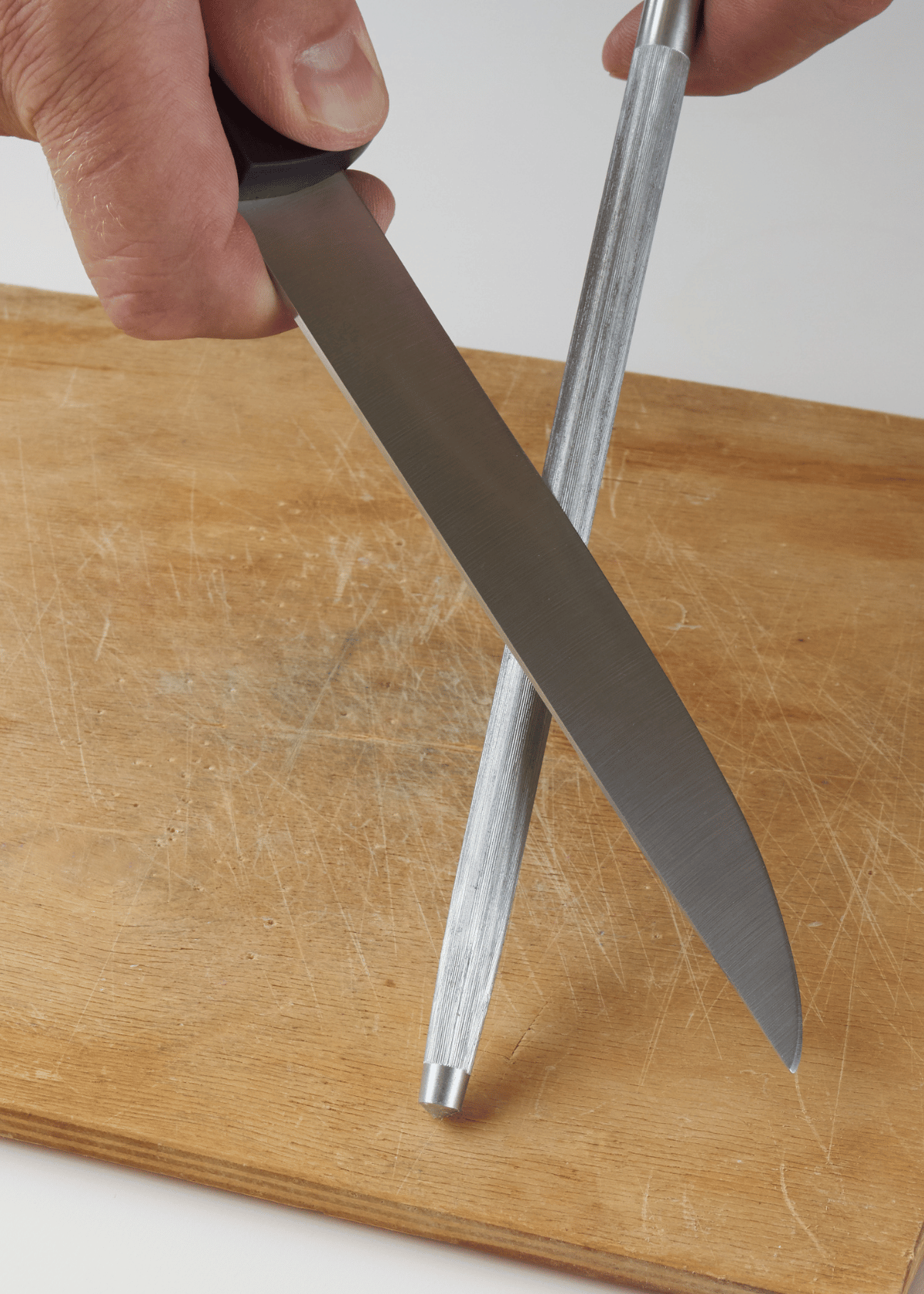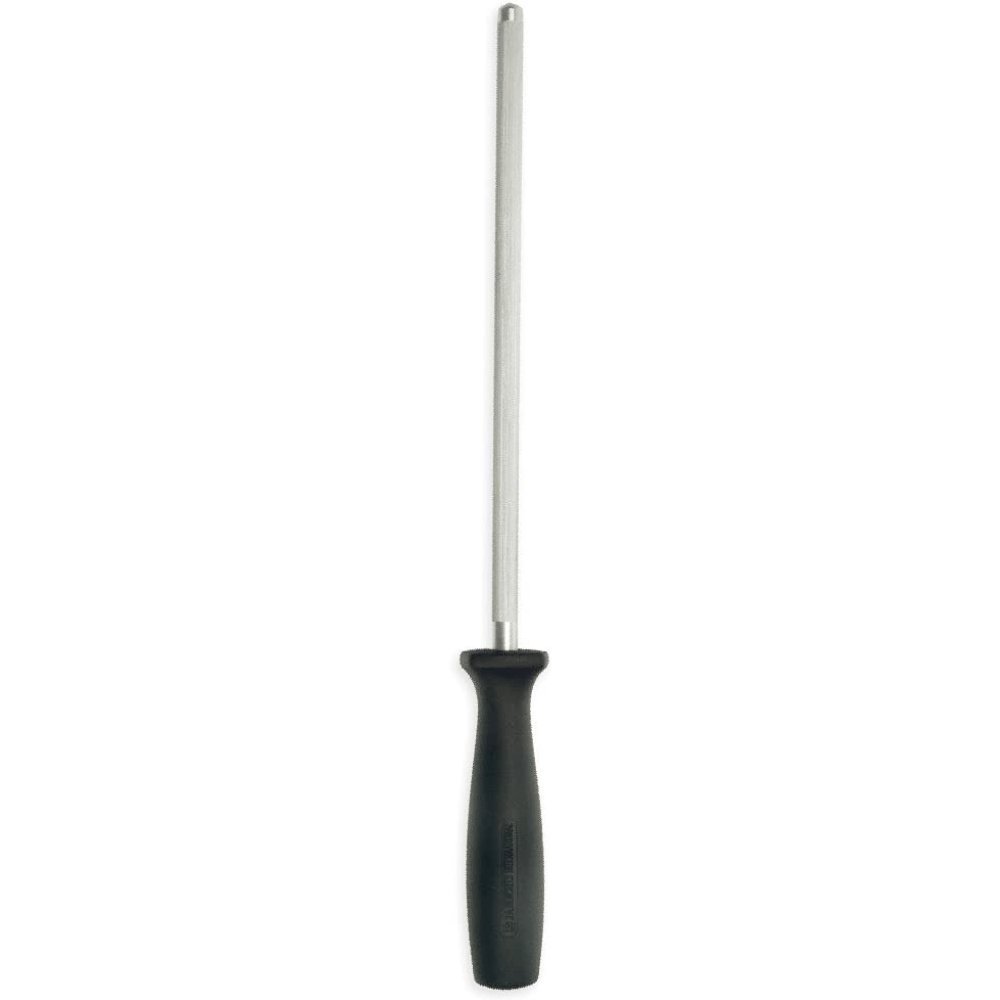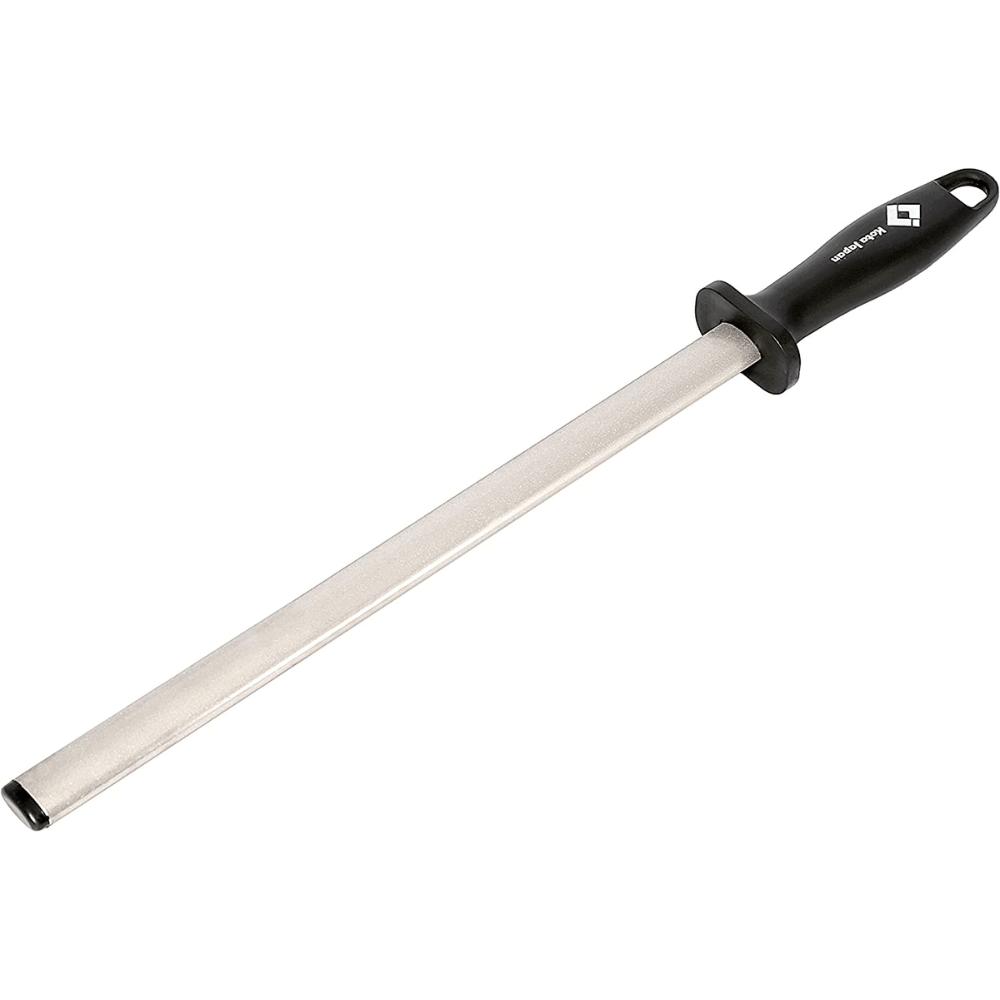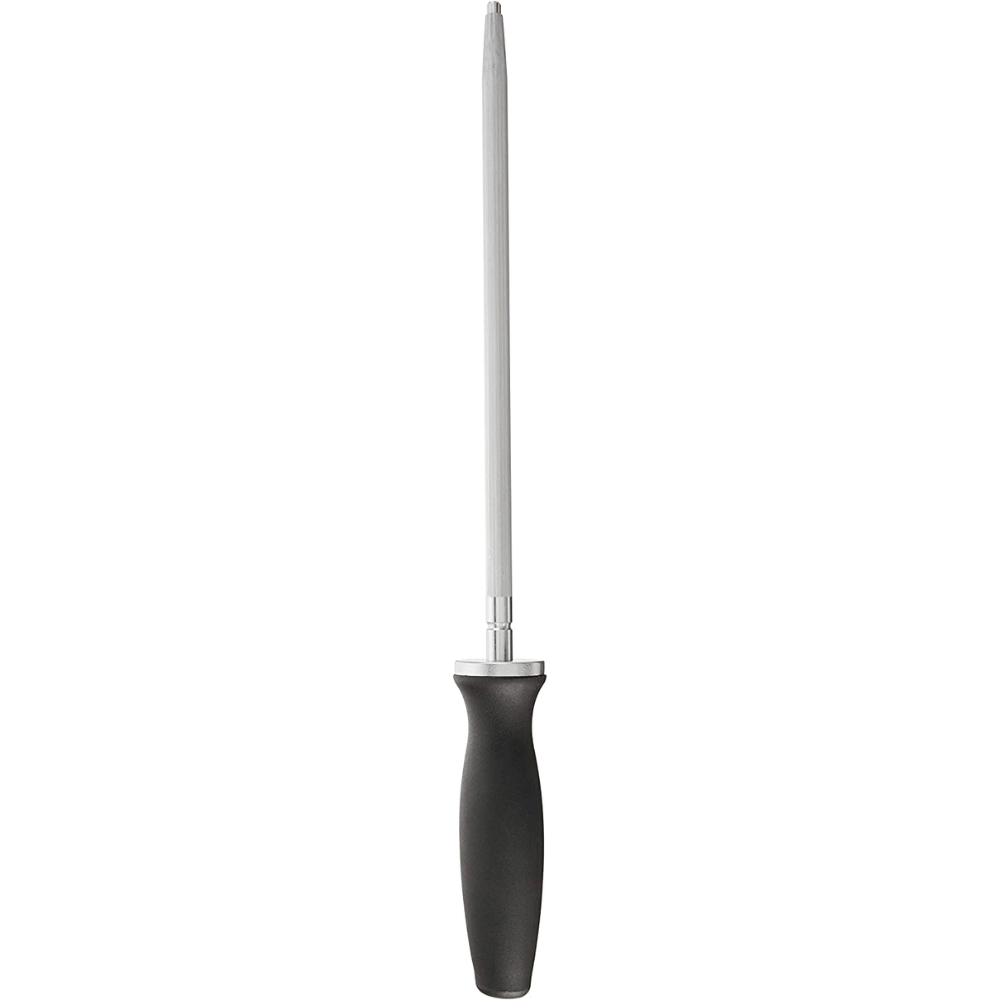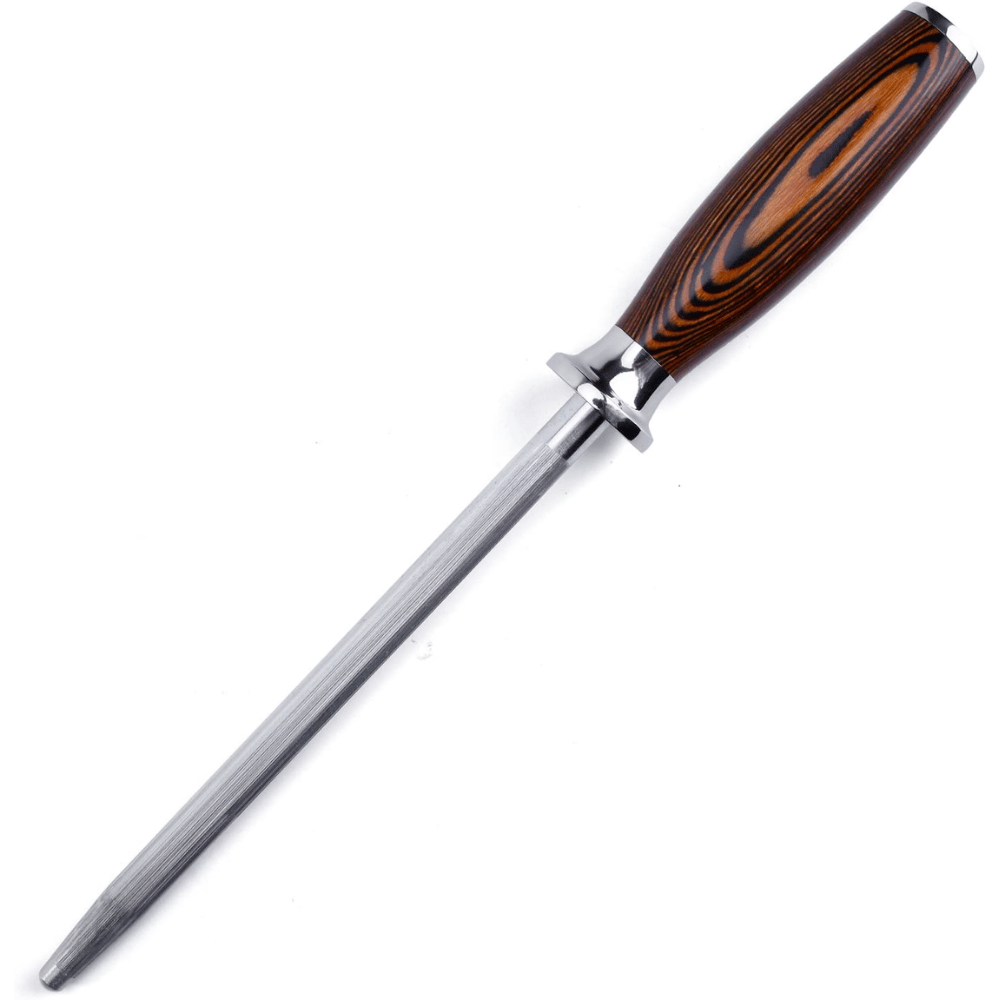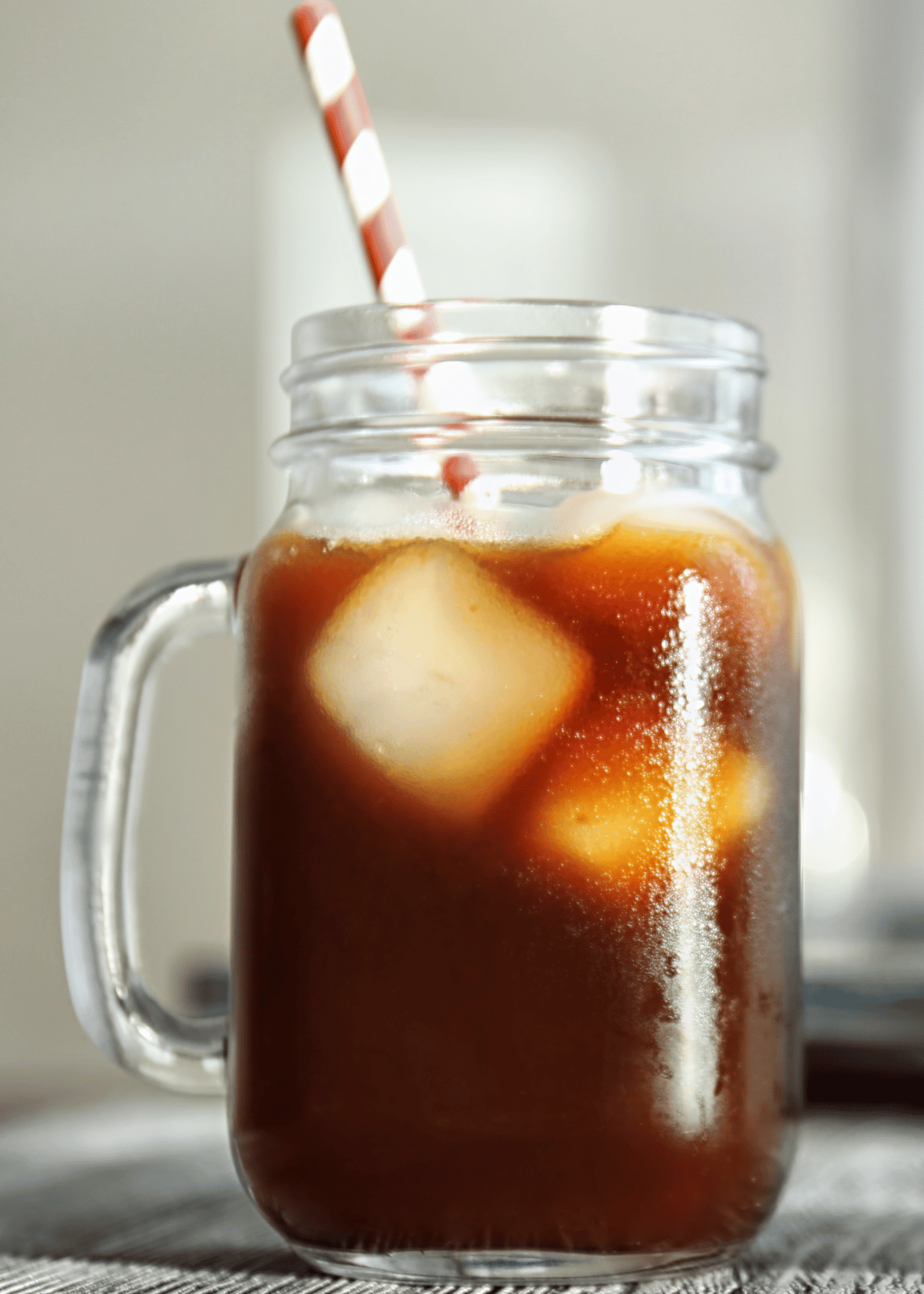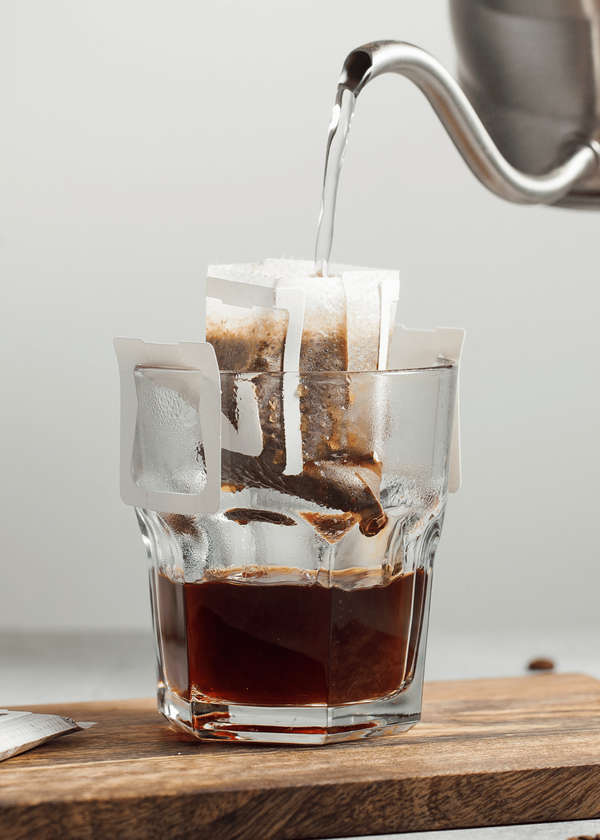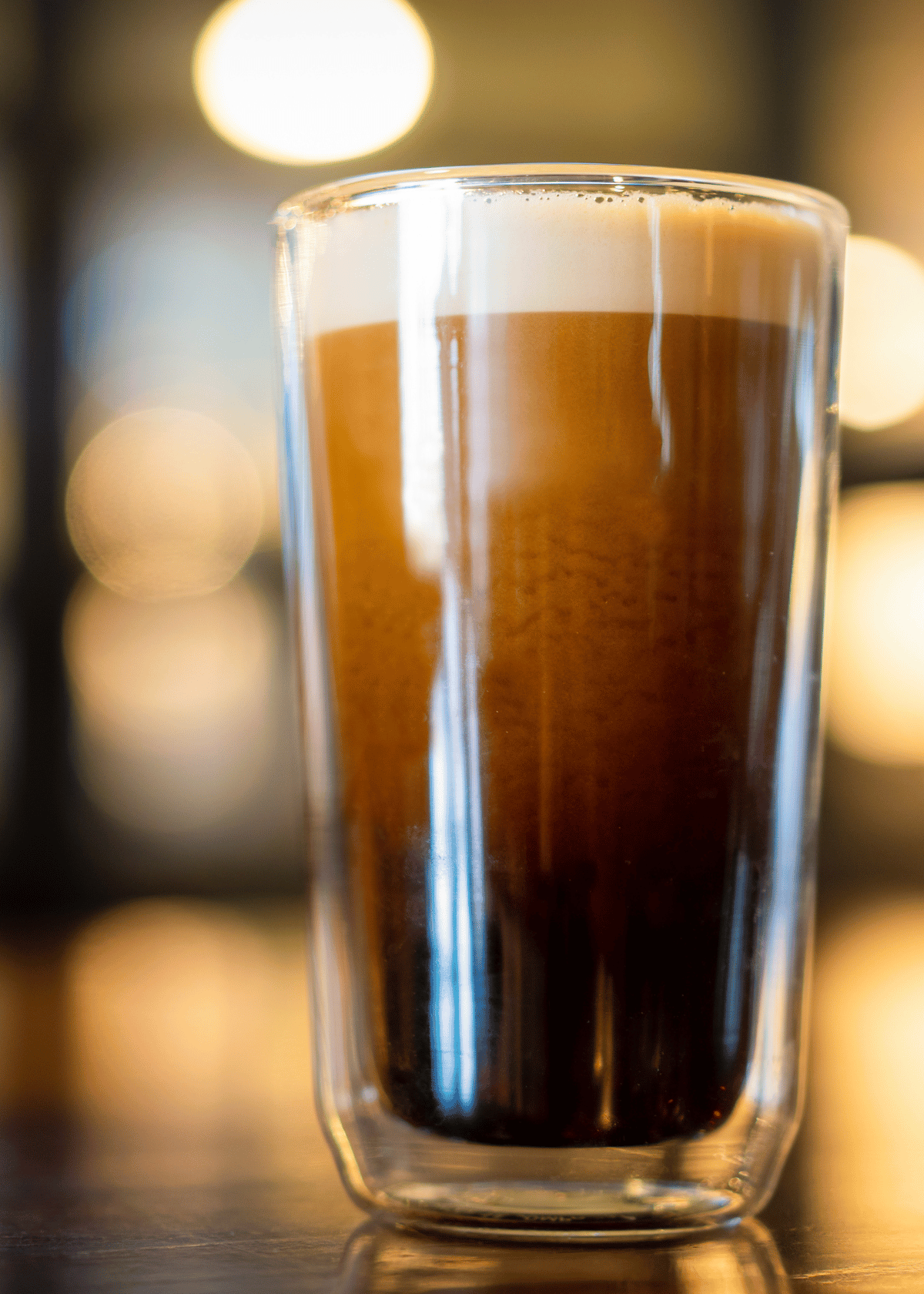Tired of dull knives? Cut your food prep time in half by getting the sharpest knives on the market!
We've done our research and created a buyer's guide to help you find the best knife steel for your budget. With this guide, you'll learn all about the different types of knife steel available, as well as what type is best suited for budget-minded shoppers who still want top-notch quality.
Get ready to take your cooking experience to a whole new level with sharp blades that make cutting through even the toughest materials easier than ever before. Say goodbye to nicks, slips and sluggish slicing – you deserve better!
Read our comprehensive buyers guide today and start shopping for knife steels perfect for any budget!
How We Choose The Best For You
Knife sharpening can be a daunting task. You don't want to ruin your knives by using the wrong sharpening tool, and you don't want to spend a fortune on something that might not work.
It's hard to know which knife sharpening steel is right for you, and even harder to find honest reviews from people who have actually used the product.
We've done the hard work for you. We've read through thousands of Amazon reviews to find the best knife sharpening steels for your needs, whether you're looking for a small, affordable option or something more heavy-duty.
Why We Mention It
Not only is this sharpening steel incredibly easy to use, it's also a great value for money. Designed with a wonderful weight, great length, and ergonomic shape for easy manipulation and comfort during use, this tool allows you to quickly and subtly sharpen blades with finesse in just a few seconds. And now that you can have all of this power without breaking the bank, why compromise on form or function? Quality is guaranteed too - each sharpener comes with a lifetime warranty - so you can be sure your investment will last as long as possible. Trust Henckels to bring us maximum quality at minimum cost!
Some Facts You Should Know
No more dull, ineffective cutting - this sharpener will help make sure you have a finely honed edge every time you reach for your knife. With a stainless steel shaft and smooth polypropylene handle, our fine-edge model with a lifetime guarantee is both comfortable and durable. Plus, made in China, you can be sure of its top-notch material quality.
When it comes to kitchen prep, nothing gets the job done like a sharp blade. The Henckles Fine Edge Pro Sharpening Steel ensures that your knives are always at their best performance; use in between professional sharpenings for optimal results.
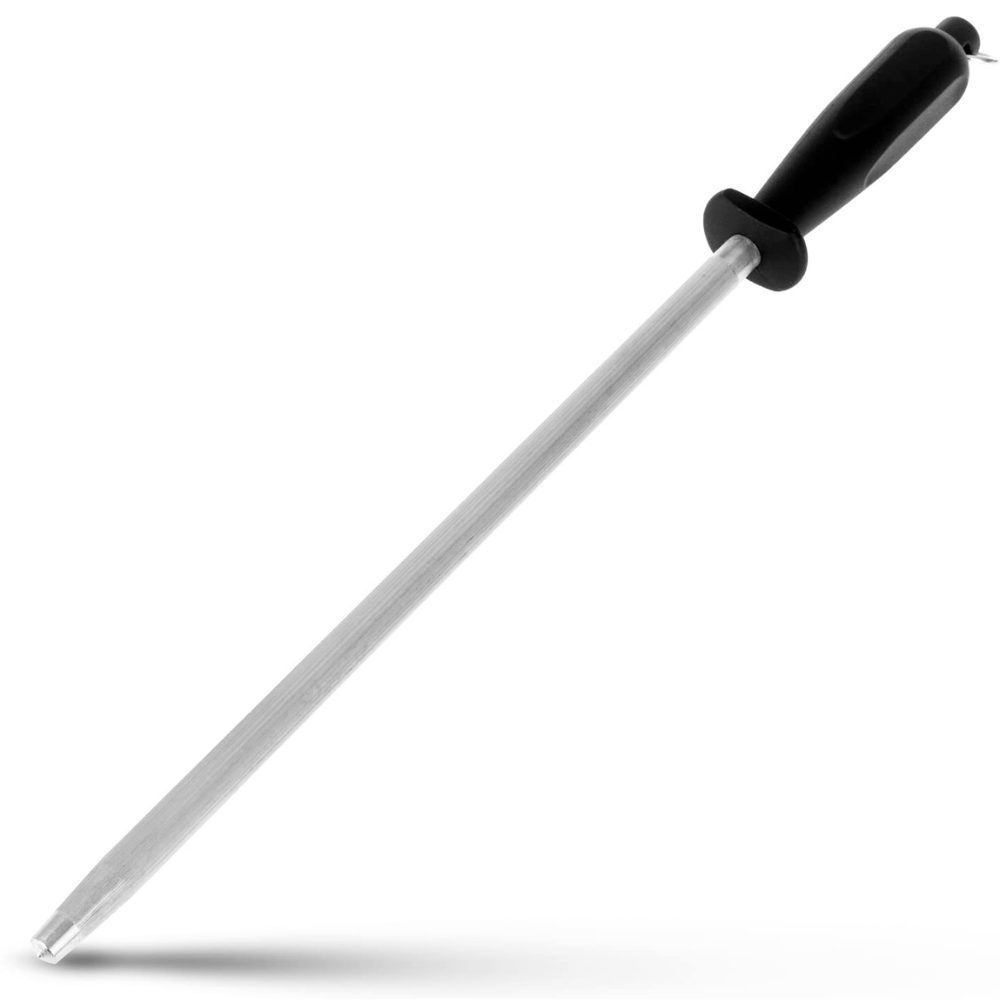
ALLWIN-HOUSEWARE Professional Carbon Steel Black Knife Sharpening Steel
Best Budget 12” Knife Steel
Why We Mention It
Make sure that you always have an exceptionally sharp knife for all of your daily cutting tasks with the ALLWIN-HOUSEWARE Professional Carbon Steel Black Knife Sharpening Steel. This professional-grade knife sharpening tool is specially designed with a long notice length to ensure that it works perfectly, while remaining safe and protected from accidentally damaging the counter top. It also features its very sturdy manufacturing, offering heft and feel of quality that simply cannot be matched by lower-quality alternatives!
Easily sharpen already sharp knives at home or in any professional kitchen with this practical knife sharpening steel. Its ideal length provides enough leverage to get the job done right and fast, while its handle properly protects your hand from accidental cuts. Enjoy expert results each time you use this top-notch sharpening steel – it's guaranteed to put a finer edge on every single blade that passes through it! Get your ALLWIN-HOUSEWARE Professional Carbon Steel Black Knife Sharpening Steel today, and enjoy professional-level sharpness without ever leaving home
Some Facts You Should Know
Boasting a 12" sharpening steel made of carbon steel plated with nickel-chrome, this sharpening tool helps to maintain the edge on your knives and prolong their longevity. The ergonomic handle designed of easy-to-grip polypropylene makes it comfortable to use even during long periods and has a hole for convenient hanging storage. After use, simply wipe clean with a damp cloth for an easy cleanup. With its sturdy construction and pocket-friendly price point, the ALLWIN-HOUSEWARE Professional Carbon Steel Black Knife Sharpening Steel is your ideal choice for keeping your kitchen cutlery in perfect condition.
Why We Mention It
Introducing the Kota Japan 12 in. Diamond Carbon Steel—the perfect choice for honing and sharpening your kitchen knives! This diamond hone is an inexpensive and efficient way to keep your blades in great shape. With just a few swipes, you can quickly get a polished edge on any knife, with excellent results that leave it looking like new.
Thanks to its well-balanced weight and narrow profile, the Kota Japan 12 in. Diamond Carbon Steel fits well in most hands, giving you total control during use - plus, the included rubber tip prevents slipping as you work. And since this hone uses carbon steel plates with diamonds as the abrasive surface, you will get a sharper edge than other traditional sharpening implements.
For ease of sharpening, storage and transportation, this honing tool easily fits into any drawer or cupboard without taking up much space.
Some Facts You Should Know
Built with precision and craftsmanship, it requires much less force than most sharpening steels, making it simple to use in your kitchen space and giving you long-lasting results. Not only is this tool incredibly easy to use but its modern yet classic design is also a great addition to any workspace. This knife sharpener rod also comes with an unconditional lifetime guarantee backing it so you can feel confident in your purchase.
Why We Mention It
With perfect balance and a well-made design, this is the perfect tool for honing knives to their sharpest form. Its quality construction and hard material make it excellent for the final step of the sharpening process.
Engineered with precision and over decades of culinary experience, this steel is sure to meet all of your knife sharpening needs. Made with a smooth finish, it feels comfortable in your hand while also providing immense durability. Each stroke will place your knives back into that precise, professional sharpness that every chef desires.
The Mercer Culinary Genesis Knife Sharpening Steel is an essential item for any kitchen - regardless of your experience level - allowing for easy knife maintenance and reliable performance no matter what task comes up on the cutting board.
Some Facts You Should Know
The Mercer Culinary Genesis Knife Sharpening Steel is a precision forged product made with high carbon German steel to help you get the most performance out of your knife edges. We know that long-term use can take its toll on kitchen tools, so we designed this sharpening steel with a lasting ergonomic handle to ensure comfort and safety when using even in wet conditions.
Caring for your knife sharpener is key in preserving it, too. When you’re done using, simply hand wash with warm water and mild soap, rinse off and air dry before putting it back in the kitchen utensil drawer.
Why We Mention It
An essential tool for sharpening knives, this honing steel is the perfect fit for chefs who are seeking peak performance from their cutlery. This unsurpassed honing steel has revolutionary characteristics that make it stand apart from all other honing steels:
First and foremost, its design exudes quality craftsmanship. Built to last with a sleek design, this honing steel is constructed of high-quality materials that provide exceptional durability as well as reliability. Not only does it boast an attractive design, but its weight adds to its functionality. Its light weight makes it incredibly comfortable to hold while in use without sacrificing any efficiency of function.
In addition to its beautiful exterior, this honing steel works exactly as it should – with precise accuracy and responsive sharpening capabilities that bring your knives back to life time after time – making sure every cut is precise and precise each time you slice.
Designed not just for style and effectiveness, but also for longevity, the TUO Honing Steel provides the ideal solution for sharpening your knives for years and years to come. So whether you're a home or professional chef, this honing steel has you covered - bringing your kitchen crisp, accurate cuts with each use!
Some Facts You Should Know
The 9” length of this steel makes it the perfect tool for most sized knives, as it is neither too long nor too short to become cumbersome. Don’t worry about quality either; our honing steel is sure to last for a long time! The durable construction and user-friendly design make it an excellent choice for professional chefs and home cooks alike.
Equipped with a 100% satisfaction or money back guarantee, our TUO Honing Steel is designed to exceed your expectations. Leave those dull edges behind, and take control of your cuts in the kitchen. Perfectly balanced blade bevels allow you to slice through any ingredients while creating even amounts of paper-thin slices with consistent texture and size. Now you can prep meals and dishes with ease!
Knife Steel FAQs
Knife sharpening can be a daunting task. There are so many different ways to sharpen a knife, and it's hard to know which method is the best for your specific knife.
It's no wonder that so many people are intimidated by the thought of sharpening their knives. With all of the conflicting information out there, it's hard to know where to start.
We've compiled a list of the most frequently asked questions about knife sharpening steels. This guide will help you determine which type of steel is best for your knives, and walk you through the sharpening process step-by-step.
How can I make sure my knife steel is corrosion resistant during sharpening?
There are a few ways to make sure your knife steel has corrosion resistance during sharpening. One way is to make sure the steel you're using is designed for use with water (or some other lubricant). Another way is to make sure that the steel you're using is coated in a corrosion-resistant material. And finally, you can also coat your knife steel in a corrosion-resistant material yourself.
What are the differences between stainless steels and carbon steels when it comes to sharpening?
One of the key differences between stainless steel and carbon steel is that stainless steel is more corrosion resistant. This means that it's less likely to rust or corrode over time, which can lead to a blade losing its sharpness. Carbon steel, on the other hand, is less corrosion resistant and will corrode more easily than stainless steel.
This doesn't mean that carbon steels can't be sharpened - they can - but it does mean that you'll need to take extra care to protect them from corrosion if you don't want them to lose their sharpness over time. You can do this by using a rust-preventing oil or wax on the blade, or by keeping it in a humidity-controlled environment.
When sharpening a knife, how often should I use the steel?
It depends on the type of knife and how much you use it. Generally speaking, knives made from carbon steel will need to be sharpened more often than those made from stainless steel. If you are using your knife every day or multiple times per day, then you should use the steel every couple of days to maintain its sharpness. If you are using it less frequently, then you can get away with only using the steel once a week or so. It's important to note that even if your knife appears to be sharp, it may still benefit from periodic honing with a honing steel.
What type of steel should be used in knife blades when looking for a sharpened edge?
Different types of steel can produce different sharpened edges.
Carbon steel is a type of steel that is composed of carbon and iron. When used in knife blades, carbon steel can produce a sharpened edge that is able to hold its edge longer than stainless steel knife blades. However, carbon steel knife blades are also more susceptible to rusting than stainless steel knife blades.
Stainless steel is a type of steel that contains chromium and nickel in addition to iron. Stainless steel knife blades are less likely to rust than carbon steel knife blades, but they may not hold their edge as long as carbon steel knife blades.
In general, carbon steel is the preferred choice for those who are looking for a sharpened edge that will last longer. However, stainless steel may be better suited for those who don't want to worry about rusting and prefer an easier maintenance routine.
How do I know which blade steel will be easiest to sharpen?
The "hardness" of a blade steel is usually the main factor in how easy it is to sharpen. Harder steels are more wear-resistant and hold an edge longer, but they're also more difficult to sharpen. Softer steels are easier to sharpen, but they don't hold an edge as well and they're more susceptible to damage.
The best way to determine how easy a steel will be to sharpen is to look at the Rockwell scale Hardness rating for that particular steel. The higher the rating, the harder the steel. For example, AUS-8 has a Rockwell scale Hardness rating of 58-60, while S30V has a rating of 61-63. This means that S30V is a harder steel and therefore more difficult to sharpen.
It's also important to note that different sharpening techniques can affect how easy it is to sharpen a particular blade steel. For example, using a wet stone with diamond abrasives is usually the easiest way to sharpen harder steels, but it can be used to sharpen softer steels as well. Ultimately, it's important to find a method that works best for your particular blade steel.
How do I get a sharp edge on a knife blade by using different sharpening techniques?
If the knife blade is made of a hard metal, like steel, you can use a sharpening stone to get a sharp edge on it. First, find the angle you need to sharpen the blade at. This is usually around 20 degrees. Then hold the knife blade against the sharpening stone and move it back and forth along the length of the blade. You should use light pressure when doing this.
If the knife blade is made of a softer metal, like aluminum, you can't use a sharpening stone to get a sharp edge on it. Instead, you can use a honing rod to get a sharp edge on it. First, find the angle you need to hone the blade at. This is usually around 10 degrees. Then hold the honing rod against the blade and move it back and forth along the length of the blade. You should use light pressure when doing this as well.
No matter what sharpening technique you use, it's important to make sure that you keep the edge clean and free of burrs. If you don't, it could lead to a dull edge or even a damaged blade. Once the knife is sharpened and honed, it should be tested on an appropriate surface, like a piece of cloth or leather, to ensure that the edge is at its sharpest.
Once you've achieved the desired sharpness, make sure to use a sharpening stone or honing rod regularly to maintain the blade's edge. This will not only keep it at its sharpest but also help extend the life of the blade. By regularly maintaining your knife with proper sharpening techniques, you'll be able to enjoy your knife for years to come.
What is tool steel and what makes it a good material for knives to hold an edge after sharpening?
Tool steel is a special type of alloy steel that is typically composed of carbon, chromium, vanadium, molybdenum, and tungsten. These metals are added to the steel in specific amounts to create a very hard material that can hold an edge well after sharpening.
In addition to its hardness and edge-holding capabilities, tool steel also has good toughness (resistance to breaking or chipping) and ductility (ability to be bent without breaking). This makes it a good material for knives and other cutting tools.
While tool steel is harder and more wear-resistant than other steels, it can still be sharpened relatively easily with the right tools. Generally speaking, most tool steels are best sharpened using diamond stones or carbide blades. This allows you to maintain a sharp edge without having to constantly re-sharpen your blade due to wear.
Overall, tool steel is an ideal material for knives as it can hold an edge well after sharpening and is relatively easy to sharpen when needed. It also has good toughness and ductility which makes it a great choice for those who want a knife that will last them a long time.
Which blade steel has better edge retention and high wear resistance when sharpened correctly?
There is no definitive answer to this question because it depends on a number of factors, such as the type of steel, the heat treatment, and the sharpening. However, certain steels are known for having better edge retention and high wear resistance than others. For example, vanadium-rich steels are often considered to have excellent edge retention and high wear resistance. Other common choices include stainless steels, high-carbon steels, and tool steels.
Generally speaking, steels with higher carbon content tend to have better edge retention than those with lower carbon content. Additionally, heat treatment can also play an important role in how well a steel can hold its edge. Generally speaking, it is best to work with a professional to properly heat treat your blade steel in order to get the best results.
Finally, how well a knife is sharpened can also play a role in its edge retention and wear resistance. If the knife is not sharpened correctly, it could lead to an overly-dull blade or even damage the blade itself.
Is there a difference in edge geometry between different types of blades when considering proper sharpening techniques?
Yes. There are a number of different edge geometries, and each has its own strengths and weaknesses. Some edge geometries are better for slicing, others for chopping, still others for piercing.
In order to maintain the sharpness of a blade, it is important to use the proper sharpening technique for the type of edge geometry. For example, a blade with a convex edge should be sharpened with a honing rod that has a corresponding convex curve, while a blade with a flat edge should be sharpened with a honing rod that has a flat surface.
If you're not sure what type of edge geometry your blade has, you can usually tell by looking at the angle between the blade and the edge. If it is greater than 20 degrees, then it likely has a convex edge. If it is less than 10 degrees, then it likely has a flat or hollow ground edge.
Overall, understanding the different types of edge geometry and using the proper sharpening techniques for each is essential for keeping your blade sharp and in good condition.
Are there any other tips for sharpening and maintaining a tool steel knife?
Yes, there are a few other tips that can help with sharpening and maintaining a tool steel knife. First, always make sure to use the appropriate lubricant when sharpening. This helps prevent overheating of the blade which can damage it. Second, keep the blade clean and oiled to prevent rusting. Lastly, if you notice any deformation or warping of the blade, seek professional help from a knife repair expert or smith. This can help prevent further damage and ensure that your knife remains in good condition for as long as possible.
Overall, sharpening and maintaining a tool steel knife can be a complex process, but following these tips can help ensure that your blade stays sharp and performs well for years to come.
What benefits does Damascus or carbon steel offer compared to other materials for knife blades when considering their ability to stay sharp after being honed and polished?
Damascus steel blades, also called pattern-welded blades, are made from two or more different types of steel that are forge-welded together. This creates a layered effect that results in a beautiful and distinctive blade.
The layers of different steels make the blade harder and more flexible than a single type of steel would be. This makes Damascus knives less prone to chipping and shattering than other knives, and they can be honed to a finer edge. Carbon steel is another type of steel that is used for knife blades. It is harder than stainless steel, but it is also more brittle and can rust if not properly cared for.
Both Damascus and carbon steel blades offer superior edge retention when compared to other materials for knife blades. This is due to the high hardness of the materials, which are harder than stainless steel and even titanium. With proper sharpening and honing techniques, these types of knives can stay sharp for a long time after being polished. Additionally, their layered construction makes them very resistant to chipping and breaking.
What Is The Best Knife Steel For You?
All in all, knife sharpening is a pretty daunting task. You don't want to ruin your knives by using the wrong sharpening tool or paying for something that doesn't work.
With so many different options to choose from online and in stores, it can be hard to know where to start when selecting the perfect knife sharpening steel. To make your selection process easier, we've done the hard work for you and have read thousands of Amazon reviews to find the best knife sharpening steels for any budget.
Take a look at our list of top-rated knife sharpeners and compare features, price, and ratings to find the perfect tool for you! If you're ready to buy now, just click the check price button on an Amazon product page to check out their latest prices.

